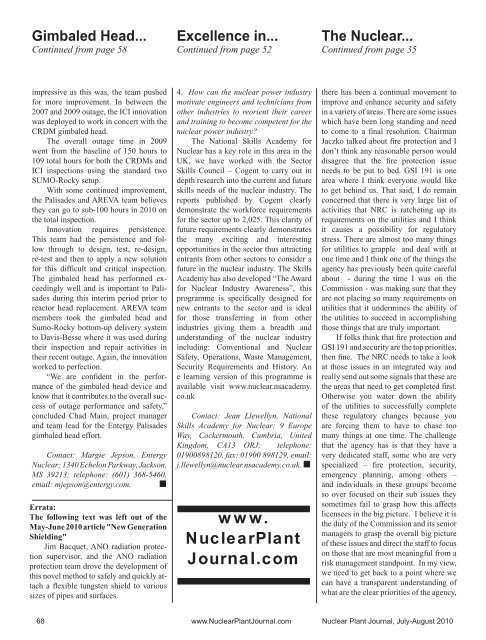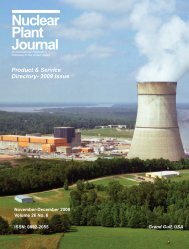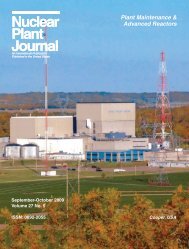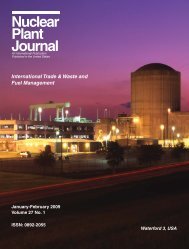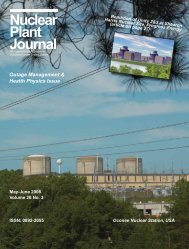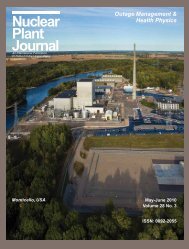Nuclear Plant Journal - Digital Versions
Nuclear Plant Journal - Digital Versions
Nuclear Plant Journal - Digital Versions
- No tags were found...
Create successful ePaper yourself
Turn your PDF publications into a flip-book with our unique Google optimized e-Paper software.
Gimbaled Head...Continued from page 58Excellence in...Continued from page 52The <strong>Nuclear</strong>...Continued from page 35impressive as this was, the team pushedfor more improvement. In between the2007 and 2009 outage, the ICI innovationwas deployed to work in concert with theCRDM gimbaled head.The overall outage time in 2009went from the baseline of 150 hours to109 total hours for both the CRDMs andICI inspections using the standard twoSUMO-Rocky setup.With some continued improvement,the Palisades and AREVA team believesthey can go to sub-100 hours in 2010 onthe total inspection.Innovation requires persistence.This team had the persistence and followthrough to design, test, re-design,re-test and then to apply a new solutionfor this difficult and critical inspection.The gimbaled head has performed exceedinglywell and is important to Palisadesduring this interim period prior toreactor head replacement. AREVA teammembers took the gimbaled head andSumo-Rocky bottom-up delivery systemto Davis-Besse where it was used duringtheir inspection and repair activities intheir recent outage. Again, the innovationworked to perfection.“We are confident in the performanceof the gimbaled head device andknow that it contributes to the overall successof outage performance and safety,”concluded Chad Main, project managerand team lead for the Entergy Palisadesgimbaled head effort.Contact: Margie Jepson, Entergy<strong>Nuclear</strong>; 1340 Echelon Parkway, Jackson,MS 39213; telephone: (601) 368-5460,email: mjepson@entergy.com. Errata:The following text was left out of theMay-June 2010 article "New GenerationShielding"Jim Bacquet, ANO radiation protectionsupervisor, and the ANO radiationprotection team drove the development ofthis novel method to safely and quickly attacha flexible tungsten shield to varioussizes of pipes and surfaces.4. How can the nuclear power industrymotivate engineers and technicians fromother industries to reorient their careerand training to become competent for thenuclear power industry?The National Skills Academy for<strong>Nuclear</strong> has a key role in this area in theUK, we have worked with the SectorSkills Council – Cogent to carry out indepth research into the current and futureskills needs of the nuclear industry. Thereports published by Cogent clearlydemonstrate the workforce requirementsfor the sector up to 2,025. This clarity offuture requirements clearly demonstratesthe many exciting and interestingopportunities in the sector thus attractingentrants from other sectors to consider afuture in the nuclear industry. The SkillsAcademy has also developed “The Awardfor <strong>Nuclear</strong> Industry Awareness”, thisprogramme is specifically designed fornew entrants to the sector and is idealfor those transferring in from otherindustries giving them a breadth andunderstanding of the nuclear industryincluding: Conventional and <strong>Nuclear</strong>Safety, Operations, Waste Management,Security Requirements and History. Ane learning version of this programme isavailable visit www.nuclear.nsacademy.co.ukContact: Jean Llewellyn, NationalSkills Academy for <strong>Nuclear</strong>; 9 EuropeWay, Cockermouth, Cumbria, UnitedKingdom, CA13 ORJ; telephone:01900898120, fax: 01900 898129, email:j.llewellyn@nuclear.nsacademy.co.uk. www.<strong>Nuclear</strong><strong>Plant</strong><strong>Journal</strong>.comthere has been a continual movement toimprove and enhance security and safetyin a variety of areas. There are some issueswhich have been long standing and needto come to a final resolution. ChairmanJaczko talked about fire protection and Idon’t think any reasonable person woulddisagree that the fire protection issueneeds to be put to bed. GSI 191 is onearea where I think everyone would liketo get behind us. That said, I do remainconcerned that there is very large list ofactivities that NRC is ratcheting up itsrequirements on the utilities and I thinkit causes a possibility for regulatorystress. There are almost too many thingsfor utilities to grapple and deal with atone time and I think one of the things theagency has previously been quite carefulabout - during the time I was on theCommission - was making sure that theyare not placing so many requirements onutilities that it undermines the ability ofthe utilities to succeed in accomplishingthose things that are truly important.If folks think that fire protection andGSI 191 and security are the top priorities,then fine. The NRC needs to take a lookat those issues in an integrated way andreally send out some signals that these arethe areas that need to get completed first.Otherwise you water down the abilityof the utilities to successfully completethese regulatory changes because youare forcing them to have to chase toomany things at one time. The challengethat the agency has is that they have avery dedicated staff, some who are veryspecialized – fire protection, security,emergency planning, among others –and individuals in these groups becomeso over focused on their sub issues theysometimes fail to grasp how this affectslicensees in the big picture. I believe it isthe duty of the Commission and its seniormanagers to grasp the overall big pictureof these issues and direct the staff to focuson those that are most meaningful from arisk management standpoint. In my view,we need to get back to a point where wecan have a transparent understanding ofwhat are the clear priorities of the agency,68 www.<strong>Nuclear</strong><strong>Plant</strong><strong>Journal</strong>.com <strong>Nuclear</strong> <strong>Plant</strong> <strong>Journal</strong>, July-August 2010


